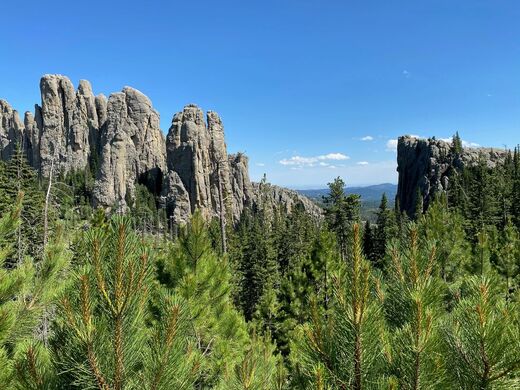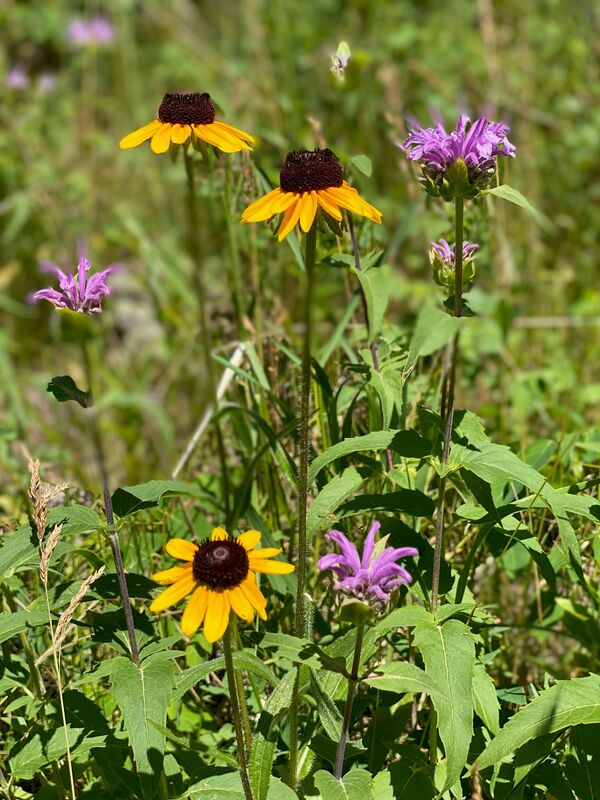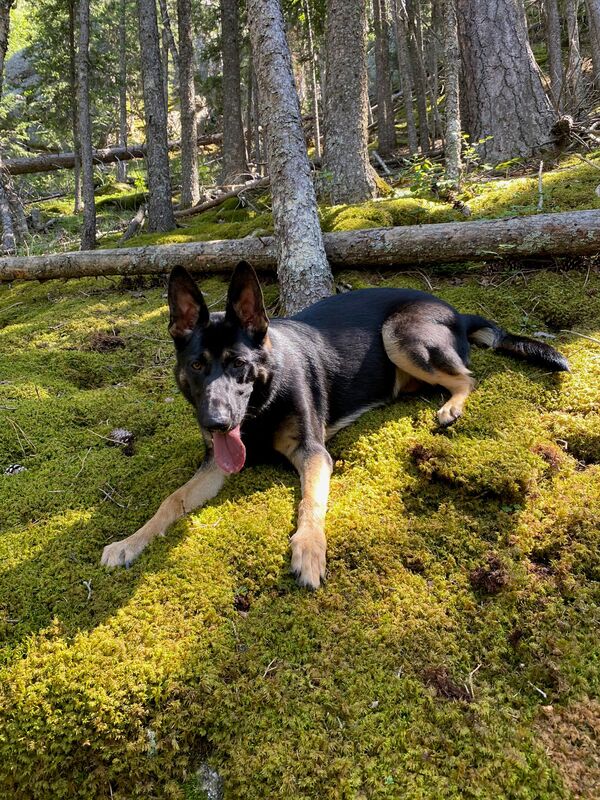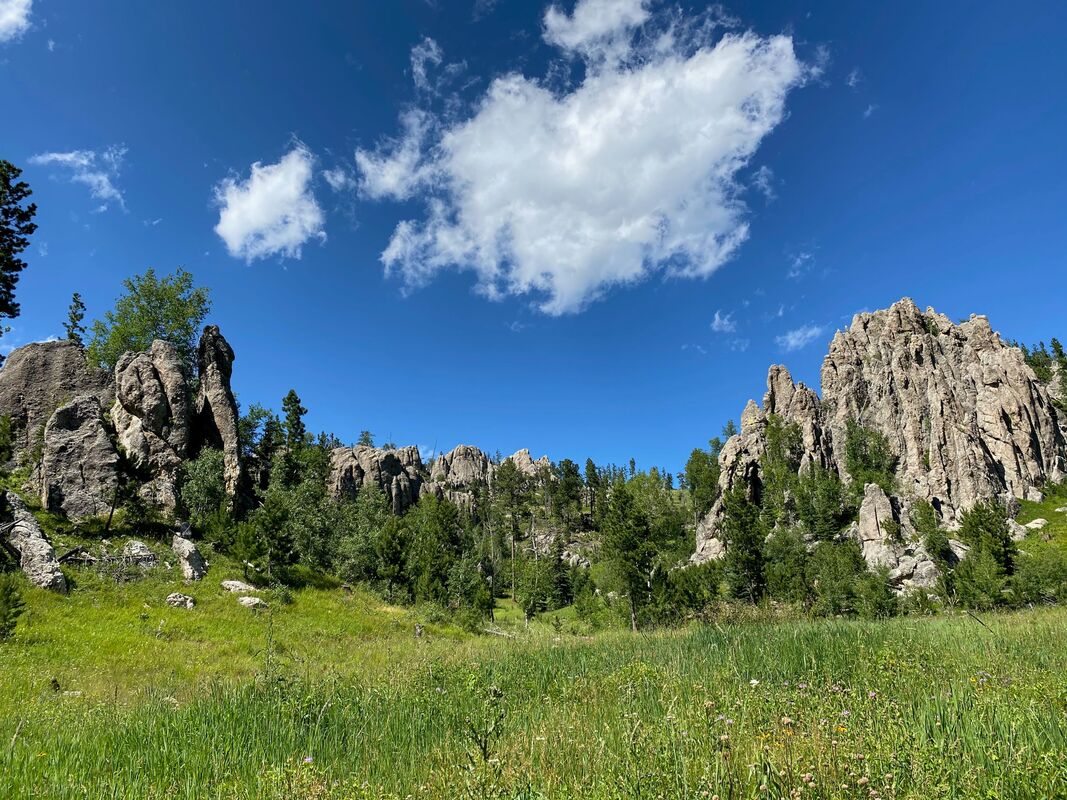Little Devil's Tower Trail #4
Custer, SD
Map: https://gfp.sd.gov/userdocs/csp-trail-guide.pdf
Know Before You Go: This trail is very popular and can be heavily-trafficked at times. Getting to the top of Little Devil’s Tower requires some rock scrambling, which is not dog-friendly and could be a lot for little kids to handle. If you’re headed to Black Elk/Harney Peak, take plenty of water - including for your dog - as there is very little fresh water along the trail after the spring runoff is finished.
Length: 2 miles out and back to Little Devil’s Tower, 8.5 miles out and back to Black Elk/Harney Peak.
Time: 5 hours with stops if you go to Black Elk/Harney Peak. 2 hours with stops to Little Devil's Tower and back.
Difficulty level: Difficult because of the rock scrambling at Little Devil’s Tower. Moderate to strenuous for the rest of it.
Terrain: Rocky, with crushed rock covering the trail in most parts.
Dog-friendly: Kind of. You need to have an extra person along to watch your dog if you want to scramble up to the top of Little Devil’s Tower. The length of hiking all the way to Black Elk / Harney Peak may challenge some dogs.
Kid-friendly: Yes, but keep a sharp eye on your kids if you take them up to the top of Little Devil’s Tower. The length may challenge smaller legs.
Custer, SD
Map: https://gfp.sd.gov/userdocs/csp-trail-guide.pdf
Know Before You Go: This trail is very popular and can be heavily-trafficked at times. Getting to the top of Little Devil’s Tower requires some rock scrambling, which is not dog-friendly and could be a lot for little kids to handle. If you’re headed to Black Elk/Harney Peak, take plenty of water - including for your dog - as there is very little fresh water along the trail after the spring runoff is finished.
Length: 2 miles out and back to Little Devil’s Tower, 8.5 miles out and back to Black Elk/Harney Peak.
Time: 5 hours with stops if you go to Black Elk/Harney Peak. 2 hours with stops to Little Devil's Tower and back.
Difficulty level: Difficult because of the rock scrambling at Little Devil’s Tower. Moderate to strenuous for the rest of it.
Terrain: Rocky, with crushed rock covering the trail in most parts.
Dog-friendly: Kind of. You need to have an extra person along to watch your dog if you want to scramble up to the top of Little Devil’s Tower. The length of hiking all the way to Black Elk / Harney Peak may challenge some dogs.
Kid-friendly: Yes, but keep a sharp eye on your kids if you take them up to the top of Little Devil’s Tower. The length may challenge smaller legs.
|
This trail leads to one of the most spectacular views in the Black Hills. The effort it takes to scramble to the top of Little Devil's Tower is well worth the reward.
This route can be used as an out-and-back trail to Little Devil’s Tower, or as an out-and-back to Black Elk/Harney Peak. You can also take Little Devil’s Tower Trail #4 up to Black Elk/Harney Peak and take Harney #9 South back down the mountain for a variety of views. #9 ends at Sylvan Lake, and from there you can take a spur trail to the trailhead parking area for Little Devil’s Tower. The trail features a steep climb up to Little Devil’s Tower. The trail passes by the well-kept secret trailhead to the Poet’s Table, over a gurgling stream, and through wildflower meadows framed by granite formations and tall pines. We hiked this in midsummer, so pulled off many times along the way to allow other hikers to pass. Almost a mile up the trail, you will come to a T-section. To go to Little Devil’s Tower (and the scrambling), take a left. To continue on to Black Elk/Harney Peak, turn right. Either way you’re guaranteed a spectacular view. We waited in line to scramble up Little Devil’s Tower, leaving one family member behind to hang out with our dog. She’s an agile German Shepherd, but the scrambling required is pretty extreme and would be dangerous for a pooch. The line was well worth the view from the top, however. The Tower’s majestic 360-degree vista is only rivaled by that from the Fire Tower at Black Elk/Harney Peak. To the east, you can see the Cathedral Spires. Looking straight down makes your heart skip a beat, with a several-hundred-foot drop off the side of the cliff. Scramble down and head back to the T-section. If your legs are feeling strong, hang a left and continue on #4 until you hit #3. Turn left (north) on #3 until you intersect with #9 South. Turn right on #9 South and follow it all the way to Black Elk/Harney Peak Fire Tower. This trail offers beautiful moss-covered hillsides under thick pine-and-aspen canopies. It runs by wondrous granite formations with trees growing from impossible spots. As you hike up the mountain, keep an eye out to the left for glimpses of the famous Black Elk/Harney Peak Fire Tower. After heading through a forested area, you will pass through an area full of blown down pines, victims of the pine beetle. Regeneration has begun, however; you can see tiny evergreens and raspberry bushes filling the void. In mid-summer, you can find flavor-filled raspberries on the bushes along the trail. Harney #9 South is very popular as it’s the shortest route up the mountain. Be sure to look up as you hike, because some of the vistas along the way rival that from the top. There’s very little water along this trail after spring runoff, so it’s a good idea to take at least two quarts of water per person/dog. Sunblock is also a good idea as there are several long open areas on this trail. About Harney Peak/Black Elk Peak: Harney Peak was first named for U.S. Army Commander General William S. Harney, who led troops against the Sioux in the Battle of Ash Hollow. It’s the highest summit in the United States east of the Rocky Mountains, and is the highest peak west of the Pyrenees Mountains in Europe. The Harney Peak Fire Tower was constructed by the federal Civilian Conservation Corps in 1938 as a place to watch for Black Hills fires, but was last staffed in 1967 when it was replaced by Mount Coolidge to the south. A U.S. Post Office was operated at Harney Peak from 1936 to 1942, and again from 1945 to 1946, and it was touted as one of the most elevated post offices in the nation. Harney Peak was renamed in 2016 for Black Elk, a famous Oglala Lakota Sioux medicine man. It’s said to be where Black Elk received his “Great Vision” as a child, as detailed in John Neihardt’s book Black Elk Speaks. The peak is sacred to the Oglala Lakota people, and you will see strips of cloth tied to trees around the fire tower honoring the area. Some signs and trail maps still refer to the peak as Harney Peak, which is why we refer to it as both Harney Peak and Black Elk Peak. |
|
Proudly powered by Weebly








